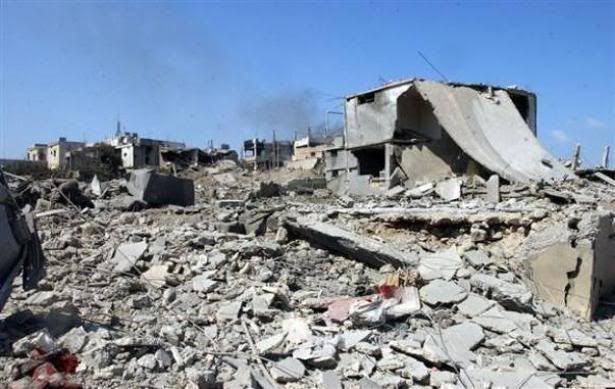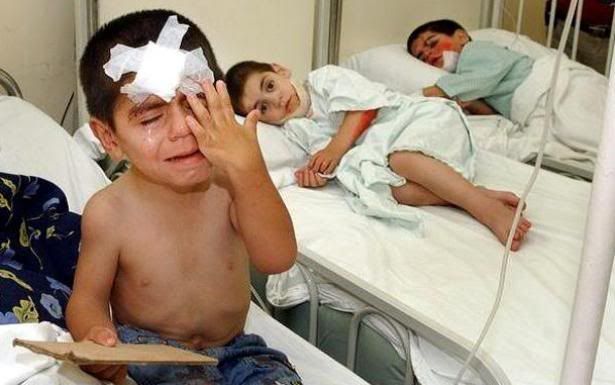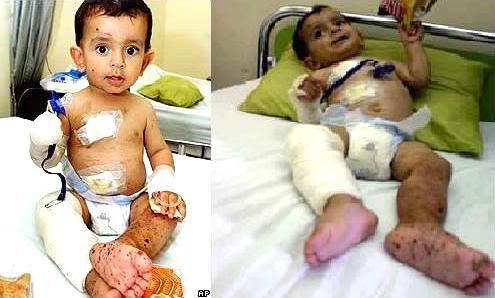Desert of trapped corpses testifies to Israel’s failure
Robert Fisk
Tuesday, 15 August 2006They made a desert and called it peace. Srifa – or what was once the village of Srifa – is a place of pancaked homes, blasted walls, rubble, starving cats and trapped corpses. . . .
New Miss USA Rima Fakih moved to the U.S. when she was 6 or 7 from the village of Srifa, in southern Lebanon. Media guyland wants ‘her controversy’ to be some sexy photos (see P.S.) but in fact there’s only one scandal connected to the new Miss USA: what Israel did to her hometown.
Srifa was a bustling hillside village. Then yesterday the Israeli jets came
Clancy Chassay outside Srifa
The Guardian
Thursday 20 July 2006
And remember the Lebanon war and its 1,300 dead was not merely Israel’s war crime, assisted by the Hezbollah, but also George Bush’s and Tony Blair’s. Robert Fisk wrote back then:
How many of these dead would have survived if George Bush and Tony Blair had demanded an immediate ceasefire weeks ago will never be known. But many would have had the chance of life had Western governments not regarded this dirty war as an “opportunity” to create a “new” Middle East by humbling Iran and Syria.
The Guardian article whose headline I provided above begins as follows:
Srifa was a bustling hillside village. Then yesterday the Israeli jets came
Aliyah, 30, lay on a life support machine in the Jabal Amal hospital in a coma. She was one of a handful of survivors who made it out of Srifa, a village in south-east Lebanon. The man treating her put her chances of survival at less than 20%. “She has severe injuries and has lost a lot of blood,” he said.
Fatima Ali Ashma was more fortunate, but not much more. She lay on a hospital bed struggling to breathe.
The force of the blast which overturned the mini van she was fleeing in crushed her chest, damaging her lungs. She sustained severe injuries to her neck and arm.
Speaking slowly and with difficulty, she described what had happened to her. “In the morning we woke up to find that 10 people in the village had been killed. The authorities told us that if we could leave we should get out. So we got in the car and left. As we were leaving, they bombed the road in front of us.” There were 10 people in the van with Fatima: all were wounded. “No ambulance could get through. Everyone who could has left Srifa, but the dead bodies are still in the houses.”
The attack destroyed 15 houses, killed at least 17, and wounded at least 30. It happened on a day in which 63 people were killed in the bloodiest day of the Middle East conflict so far.
Srifa sits on a hillside overlooking a coastal plain that leads down to a sandy bay which ends with the white cliffs of Naqora and the border with Israel. It was a local beauty spot, where tourists came to see turtles lay their eggs. But it is also in the Hizbullah heartland from which rockets been fired into Israel.
Jonathan Erasmus reported August 20, 2006 (emphasis added):
Hans Musswessels, Operations Director of the German aid agency Humedica, said that the returning residents were in immediate need of his organization’s help. “They have no food, no water, no shelter and no medical aid.”
“In terms of the damage caused by the Israeli bombs, this is most probably the worst hit town in Lebanon.”
A funeral precession compromised of local soldiers, men, women and children passed through what remains of the town, mostly silent but for the cries of the mothers who have lost there husbands and sons here.
With the bombing over for the time being, Lebanon now faces perhaps the largest humanitarian crisis in its history and the people in Srifa appear to be suffering the worst.
August 2, 2006
“The Ones Who Are Buried Alive Are Usually Safe From the Dogs”
The Total Destruction of Srifa: Mangled Bodies in the Wake of Israeli Bombs and Missiles
By Lara MarloweSrifa, Lebanon.
It was an unseemly end for 80- year-old Manaheel Jabr, flung over a bloodstained walll, grey hair falling around her shrunken black face, a collapsed ceiling pinning her down at the waist.
“It’s the grandmother,” one of the onlookers gasped when the civil defense bulldozer finally pierced a hole in the rubble of what was until two weeks ago a three-storey house.
Mrs Jabr’s corpse presented a terrible dilemma to the Lebanese Red Cross yesterday. Should they cut her in two, put the pieces in a body bag and take her to the hospital morgue, or leave her behind, in the hope that more powerful equipment could lift the concrete slab from her back and would reach her before the dogs did?
It was late afternoon and the 48-hour “pause” in aerial bombardment promised by Israel was drawing to a close. The Red Cross’s plan to retrieve 89 bodies across the war zone was about to end in failure. The Israelis, with whom the Lebanese Red Cross communicates via the International Red Cross, granted safe passage to only two of the six villages that the rescue workers wanted to visit yesterday, Srifa and Bint Jbail. And the convoy bound for Bint Jbail had to turn around because of bombing.
That left only Srifa, the site of the most dramatic devastation I have seen in this war. The entire Hay el-Birki neighbourhood – 18 buildings by some accounts – was flattened at 2 am on July 19. “The F-16s [ fighter bombers] came from the west, the Apaches [ attack helicopters from the east,” said a local Hizbullah official who identified himself as Abu Hadi.
It seemed amazing that bombs and missiles could chop buildings into so many million of grey concrete pieces, a bed of rubble many meters deep, with only the occasional slipper or coffee pot to remind one that human beings lived here.
The field of ruins stretched to the horizon, reminding me of images of second World War bombings. . . .
P.S. – As for the sexy photos ‘controversy’ (and just to show you a sexy photo of Fakih), the incredibly hypocritical Miss USA Pageant itself put out this publicity shot of Fakih (along with 50 similarly sexed up photos of the other contestants) just prior to its contest:









Thanks for reminding us about Israel’s war crimes and crimes against humanity in Lebanon, 2006 (not to mention all the crimes that preceded 2006), and about Srifa.
I must take issue with you, though, on your comment that Israel was assisted by Hezballah. If Israel was assisted in its crimes by anyone in Lebanon, it was by the Lebanon military, not Hezballah. In fact, Israel would have had a nice victory in Lebanon, and would have stayed longer and done more damage had Hezballah not mounted a very well-coordinated and disciplined defense. And yes, I know Hezballah has been known to fire rockets into Israel, but those actions are anything but unprovoked as becomes obvious to anyone who studies the UN’s daily reports of multiple Israeli violations of Lebanese territory.
You’re right, I rushed and veered too much toward U.S. ‘conventional thinking’ there. Something like “‘excuse’ provided by Hezbollah” would’ve been more accurate. As we all know, the invasion was long planned and just looking for any ‘justification’.
The horrors of the 2006 Lebanon massacre (as well as the 2006 Gaza massacre, the first one, that went on at the same time) was made possible by American armaments supplied free by the USA and its taxpayers.
Funny how things come around: it gave birth to a Miss USA.